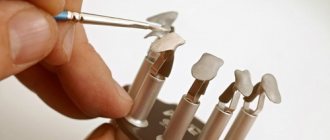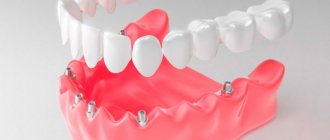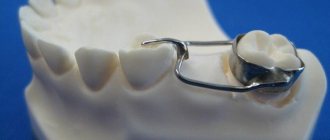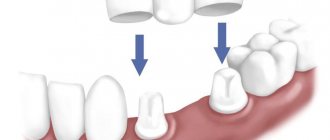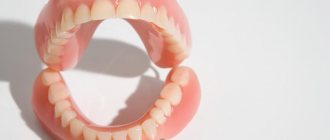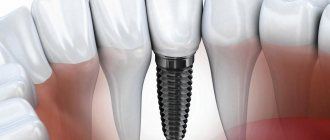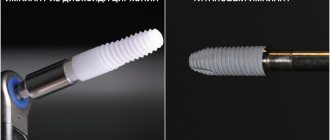- Types of prosthetics
- Materials for prosthetics
- CAD/CAM system
Not every second patient can boast of a smile with all 32 teeth.
The vast majority, some units are missing, or artificial ones are installed instead of living ones. Just like a hundred years ago, today, the most common dental problem is the absence of one or more teeth. Modern medicine offers many technologies for creating new, high-quality and reliable analogues. Prosthetic dentistry helps restore the beauty and functionality of the entire jaw. There are two types of methods for restoring the shape and appearance of a tooth – prosthetics and cosmetic restoration. They are used in different cases, depending on the clinical situation. Science is developing and offering more and more new installation methods and types of orthopedic structures. Nowadays, in almost every clinic you can find modern equipment that can carry out all types of diagnostics. With its help, the doctor can determine the diagnosis with almost one hundred percent accuracy and prescribe the necessary treatment. Before starting any dental procedure, an x-ray examination is required. The image helps to see the condition of the oral cavity in different formats: 3D or 2D.
Before proceeding with prosthetics, you will undergo all the necessary diagnostic measures, draw up an anamnesis and a treatment plan.
The latest dental prosthetics
People have been aware of the need for dental prosthetics since ancient times. The manufacture of dentures was reduced to crafts from seashells, animal bones, precious stones and even wood. But all this dental prosthetics was used only to mask the resulting defect, rather than to restore chewing function. For example, the products of ancient dental jewelers served primarily social purposes, and only then practical ones. The richest people of Ancient Rome could decorate their smiles with gold only to demonstrate their status to others.
In modern dentistry, dentures are an important part of dental treatment. The production of dentures does not stand still and constantly offers new technologies, expanding the possibilities of using various materials. It is difficult to imagine a modern person at business negotiations or at dinner with friends, giving those around him a toothless smile. Therefore, dentistry pays special attention to proper dental prosthetics, which belongs to a separate area - orthopedics. Accordingly, the doctor who performs dental prosthetics is called an orthopedist. In some clinics, dental treatment and prosthetics are performed by one doctor who specializes in orthopedics.
Features of dental prosthetics
Each type of prosthetics has its own characteristics; let’s look briefly at each of them.
Prosthetics of anterior teeth
Requires great attention to the aesthetic side, as well as the shortest possible deadlines. This is due to the fact that few patients can afford to walk for a long time with an obvious aesthetic defect or a “hole” instead of a tooth. Also, prosthetics of the upper front teeth require the use of all-ceramic structures in order to avoid metal showing through the artificial enamel or exposing it in the gingival area.
Prosthetics of chewing teeth
Prosthetics of chewing teeth require more attention to the functional side of the issue. Here, metal-ceramics are acceptable, and in some cases even more preferable, since the strength of structures becomes more important than aesthetics. As for prosthetics on implants, it is advisable to use a two-stage technique, when the implant is first placed, and the crown is installed only after its complete osseointegration.
Prosthetics of the upper jaw teeth
If they are restored after removal, they may require a preliminary sinus lift. This is due to the close location of the maxillary sinuses (sinuses) near the roots of the upper lateral teeth. Sinus lifting is a type of bone grafting that allows you to lift the bottom of the maxillary sinus and fill the vacated space with bone tissue, which will be used to fix the titanium tooth root.
Denture options
Treatment may be performed in one or more visits to the doctor. With express methods, the dental surgeon will immediately after removal install the pin in the socket and put on the crown. Multi-stage technologies are used if several weeks or months have passed since amputation or injury. Before implantation of artificial roots, the patient undergoes a sinus lift - increasing bone volume to eliminate atrophy. In the presence of carious lesions and gum disease, debridement is performed to prevent the risk of infection after the post is buried.
Traditional coronal dentures require preliminary preparation of supports. It consists in sharpening them.
Types of dental prosthetics
What types of prosthetics are there and how do they differ from each other? Dentistry divides dentures into three categories: fixed, partially removable and removable prosthetics. Fixed dentures are:
Turn on adki
Essentially, these are the same fillings, but made in the laboratory using individual impressions, usually made of ceramics. They belong to non-removable dentures. They have maximum precision of fit and high aesthetics. Unlike a conventional filling, a ceramic inlay is more durable and completely invisible on the teeth.
Ceramic veneers
Fixed dentures in the form of thin ceramic plates covering the outer surface of the teeth. As a rule, this type of permanent dental prosthetics is used in the smile area to correct the shape and color of teeth.
Lumineers
Ultra-thin ceramic plates, with the help of which dental prosthetics do not require preliminary serious treatment of the teeth. Unlike veneers, lumineers can be removed, but the list of problems they can treat is very limited.
Dental crown
A cap that replaces the crown of a tooth and imitates its natural shape. The most common option for this type of denture.
Bridge prosthesis
A design of several artificial dental crowns attached to natural teeth or roots. A classic version of dental prosthetics. This category also includes an adhesive bridge, used as a temporary aesthetic structure.
Dental implant
A titanium “root” is implanted into the bone in place of a missing tooth, on which an artificial crown is installed.
All other designs are partially removable or completely removable dentures. These include:
Plate dentures
A prosthesis made of an acrylic or nylon base with artificial teeth placed on it. Can be completely removable and rest on the mucous membrane of the edentulous areas, jaws and palate. And also – partially removable with fixing elements on natural teeth. A complete removable plate denture supported by implants is the most popular and reliable type of implantation today in the absence of teeth.
Clasp dentures
Prostheses with a metal frame, which include devices that hold and unload the structure, arches and artificial teeth. The production of dentures of this type takes place in the laboratory.
Each type of prosthesis and method of dental prosthetics solves a specific functional and aesthetic problem, starting with the ugly color of teeth and ending with their complete absence.
Comparison of methods
Without exception, all types of dentures have pros and cons:
- The easiest to install are removable and conditionally removable models. Their category includes clasp, telescopic and plate prostheses. They are inexpensive and suitable for people of all ages. Among the disadvantages are possible irritation of the mucous membrane, atrophy of bone tissue due to lack of load. The need to regularly remove and put on the device creates inconvenience in use.
- Bridge structures are several ceramic or metal crowns that are connected to each other. They are used to replace two or more elements located nearby. The advantage of the technology is durability and long service life. Disadvantages include the need for grinding, a possible risk of complications, and contraindications.
- Implantation is the most expensive and modern method of restoration. Implants can be installed immediately after removal or after the socket has healed. The advantages are their natural appearance, reliability, and the ability to eliminate any kind of defects. The disadvantages of the technique are the high cost and a considerable number of restrictions on use.
Materials for dentures
Materials used in orthopedics have special requirements. They must be biologically compatible with human oral tissues and be resistant to saliva and food. Materials should not cause allergies, change taste, or have an odor. Their strength, resilience, elasticity and abrasion should be close to the tissues being replaced. In addition, an important requirement is the possible production of dentures from these construction materials, which are as close as possible in color and appearance to natural teeth and gums. Let's take a closer look at each of them.
Metal
The first metal used to make dentures was gold. Gold teeth had an absolute monopoly for 2,500 years. And even today you can still find owners of metal dentures made of gold. But today, modern dental prosthetics most often uses various metal alloys, usually as auxiliary materials. For example, when making crowns, a metal frame is first cast and then covered with a layer of ceramic. Thus, metal-ceramic dentures are created - the most popular in dentistry today.
Ceramics
The main advantage of ceramic dentures is that they are fully compatible with soft tissue, hypoallergenic and help create natural gum contours. In addition, ceramic structures can be painted in one of the shades that most accurately conveys the natural color of teeth.
Plastic
This type of material is used to create artificial teeth and bases for removable dentures. Dental laboratories use acrylic resin-based plastics to create acrylic dentures. And with the beginning of the use of non-acrylic polymers in dentistry, polyurethane and nylon dentures appeared.
Acry Free - devices that do not chafe
The latest dental prosthetics eliminate the use of hard plastic during the manufacture of removable systems. The dental clinic offers clients designs made from soft and flexible materials. They are elastic and ensure a snug fit of the frame; they fit perfectly in the mouth even without the use of special fixing agents. What is important is that they do not rub or irritate the mucous membranes.
The new generation of removable products is called Acry Free. If we compare them with nylon predecessors, they hold their shape better, do not stretch, do not absorb food odors and do not change their color. Allergic reactions are excluded during their use. The high level of strength of the materials used in the production of Akri Free allows them to chew even hard food without fear of breakage. Getting used to soft systems is much easier. That is why today they are increasingly chosen by people who want to wear removable devices.
Technology and methods of dental prosthetics
The technology of dental prosthetics does not stand still, it is constantly evolving, outdated ineffective methods are becoming a thing of the past, more and more advanced techniques and the most modern materials are appearing. Modern technologies and methods of dental prosthetics involve the widespread use of computers at all stages from diagnostics (taking 3D X-rays) to the manufacture and installation of structures. New technologies in dental prosthetics are, for example, a CAD/CAM system that allows the production of high-precision orthopedic structures using 3D computer models by sawing on a milling machine from high-strength ceramics, while just a few years ago crowns and other prosthetics were made by casting ceramics on metal frames. Thanks to the latest technologies and methods in dental prosthetics, today it is possible to make prosthetics in one visit to the doctor, when the design is made not by a technician in a laboratory, but by a special ultra-modern and high-speed machine, on which the doctor himself models the prosthesis.
Which method of dentures to choose - recommendations from doctors
During the first visit, a dental diagnosis is performed. It will allow you to choose an effective and safe method of restoration. There are no universal techniques that suit everyone without exception. The dentist will focus on the individual clinical picture. The doctor will ask you in detail about your health status in order to exclude possible restrictions on the use of different technologies. The timing and sequence of treatment procedures are discussed with the client.
Preparing teeth for prosthetics
Before the manufacture and installation of dentures, careful preparation for dental prosthetics must be carried out. First, any current oral problems such as tooth decay or gum disease such as periodontitis must be addressed. If some chronic diseases cannot be completely cured, it is necessary to put them into remission. Also, prosthetics may require preliminary orthodontic treatment, for example, if there is a severe malocclusion or there is not enough space to install an implant. Before aesthetic microprosthetics with veneers or lumineers, it is necessary to do whitening, and a procedure such as professional teeth cleaning will be required in any case. In addition to the above measures, an orthopedic consultation includes such preliminary steps as consulting a doctor, taking x-rays, drawing up a treatment plan and choosing the optimal type of prosthetics.
Timing of dental prosthetics
The next pressing question that worries every patient is “How long does dental prosthetics take?” There are two main calculation criteria here: whether the participation of a dental technician is required in the manufacture of dentures and whether a break is necessary between the main stages of the procedure. Almost all types of orthopedic treatment discussed in this article involve the production of dentures in a dental laboratory using individual casts of the patient. This means that installation of the prosthesis will require two visits to the dentist, with a break necessary for the construction to be made in the laboratory. However, today an increasing number of clinics are acquiring the latest models of milling machines with the ability to instantly produce orthopedic structures using 3D computer models of casts. Thus, the time required for dental prosthetics is reduced to one visit to the dentist. As for dental prosthetics on implants, here you will have to prepare for a longer treatment, since several months (from four to six) necessary for the engraftment of the titanium root may pass between the implantation of the implant and the installation of a permanent crown on it.
With complete absence of teeth
What to do if all the teeth are missing, and there is simply no way to fix the structure in the mouth? Modern prosthetic technologies make it possible to solve problems of even this level of complexity.
All-on-4 dental implantation allows you to completely restore a row of teeth in the upper or lower jaw. The installation takes place in a one-time visit, which allows you to return all your teeth in one day.
The doctor secures the prosthesis on four implants. This is different from traditional methods and can significantly reduce costs.
4 implants on the lower jaw
All-on-6 technology works on a similar principle, but instead of four implants, six are used. This is necessary for more complex symptoms and allows you to secure the prosthesis in your mouth even more securely.
This type of prosthetics has been used for more than twenty years and has proven itself successfully among patients.
Stages of prosthetics
After all the preparatory procedures, the specialist proceeds directly to prosthetics, which also includes several stages.
- Preparing for installation. When prosthetics supported by implants, in some cases, preliminary bone augmentation is required. To fix a crown or dental bridge, it is necessary to depulpate, that is, remove the nerve, then fill the root and grind the surface. Before installing veneers and inlays, the doctor grinds down about 0.2 - 0.5 millimeters of dental tissue, while lumineers only need light grinding of the tooth shell.
- Making a prosthesis. Impressions of the jaw, X-rays and other necessary patient data are sent to the dental laboratory, based on which a design is created.
- Installation. The finished permanent prosthesis is adjusted to the desired size during fitting. The dentist adds highlights and shadows, adjusts the color and texture to optimally resemble the patient’s natural teeth.
Previously, depulpation was a mandatory point in the process of prosthetics, but in modern clinics doctors have different opinions about the advisability of the procedure. Removing the nerve relieves pain in the tooth area and increases its stability, but shortens the life of the tooth and accelerates tissue destruction. The specialist makes the decision on depulpation based on the diagnosis and the patient’s own feelings.
High-quality dental prosthetics
Unfortunately, the installation of dentures does not always go smoothly; sometimes incorrect dental prosthetics causes complications, and quite dangerous ones. However, it is necessary to clearly distinguish between discomfort, which invariably occurs after any serious dental intervention and is considered normal, and actual complications. If after the procedure for one, two or three days (depending on the type of prosthetics) there is slight bleeding in the area of the soft tissue incision, slight swelling or pain suppressed by painkillers, there is no need to sound the alarm, unless the pain is sharp and the bleeding not plentiful. If, within a few days after prosthetics, the tooth hurts very much, the bleeding does not stop, and the swelling does not subside, this means that the doctor made mistakes during dental prosthetics.
Dental prosthetics under anesthesia
Implant-supported prosthetics involve major surgery, so the operation is always performed under anesthesia. Patients often choose the most comfortable type of pain relief - sedation or general anesthesia. Local anesthesia is also effective, but some patients find it psychologically difficult to perceive unpleasant sounds and smells during the procedure.
Correct and high-quality installation of a crown or bridge should not cause severe pain. In this case, local anesthesia is used to alleviate discomfort during depulpation, grinding of the tooth and fixation of the structure.
When performing prosthetics with inlays and veneers, an injection of local anesthesia is used, since grinding down the dental tissue causes pain.
Stump tab
If the root of the tooth is preserved and is in good condition, then its crown part can be restored regardless of the degree of its destruction and even in its complete absence. At the same time, adjacent teeth are protected from grinding, although significant medical intervention is still required to open the canals and remove the nerves.
A stump inlay is placed in place of the damaged tooth. Most often it is a monolithic structure, but if it is necessary to restore a tooth with several roots, a collapsible model is used. The inlay has a pin installed in the canal and a stump on which a crown is hung or a bridge is installed. The support of the structure falls on the upper part of the root.
The possibility of such prosthetics is determined after examination of the root and tissues. If cysts and periodontitis are detected, surgical intervention is required. If the root is healthy, it is filled. An inlay made of metal or ceramic is tried on and fixed at a depth of 2/3 of the canal using a special filling material. It is covered with a crown or bridge.
Inlay on the front tooth
The advantages of the method are uniform load on the root, eliminating the possibility of tooth breakage and caries at the border of the inlay, ease and safety of replacement. Disadvantages include high price, manufacturing time and the need to remove living tissue to ensure a tight fit.
Pain after prosthetics
Pain after dental prosthetics can mean prosthetic stomatitis, an inflammatory disease of the soft tissues at the point of contact of the crown and gums. This may occur due to the fact that the crown is put on too “tightly”, as a result of which it puts pressure on the gum, irritating it and injuring it. Pain may occur some time after the installation of a bridge, and one or both supporting teeth begin to hurt. This may mean that caries has gotten under the dentures and affected the supporting teeth. The reason for this is the loose fit of the crowns to the teeth, too large a gap between the bridge and the gum in the place where the tooth is missing, or the ingress of saliva during prosthetics.
Also, do not forget about such an insidious phenomenon as an allergy to the materials from which prostheses are made. If you suffer from at least one type of allergy, before getting prosthetics, you should check your body for compatibility with prosthetic materials.
Photos before and after prosthetics
Cost of dental prosthetics
Prices for dental prosthetics vary widely and depend on many factors. The first is, of course, the material. The more expensive it is, the higher the cost of dental prosthetics will be. The highest prices for dental prosthetics are ceramic veneers, which are classified as permanent dentures. The lowest cost is for removable dentures made of plastic, in particular acrylic. The cost of nylon dentures will be higher. The second factor is the amount of work. It is one thing if it is necessary to compensate for the loss of one tooth, and quite another if all are missing. For example, the price of clasp prosthetics in Moscow also depends on the qualifications of the orthopedist and dental technician, the use of modern technologies and equipment when creating an orthopedic design.
Prices for aesthetic dentistry services
Consultation with a dentist - orthopedist Free Stump tab from RUB 3,900. up to 9500 rub. Ceramic inlay from 8200 rub. up to 17,500 rubles. Metal-ceramic crown CoCr from 7,200 rubles. up to 10,000 rubles. Metal-free ceramics 25,000 rubles. Ceramic veneers from 17,000 rubles. up to 30,000 rubles. Removable prosthesis 9,500 rubles. up to 18,000 rubles Clasp clasp prosthesis from 25,000 rubles up to 28,000 rubles Clasp monomer-free prosthesis 36,000 rubles Nylon prosthesis 15,000 rubles up to 34,000 rubles. Metal ceramics for implants from 20,000 rubles. up to 25,000 rub.What types of dental prosthetics are best?
Every person who decides to undergo prosthetics, of course, is concerned with the pressing question: “What type of dental prosthetics is better?” Here you must first make a reservation about what kind of prosthetics we are talking about: the restoration of destroyed or damaged teeth or the replacement of a completely missing tooth (or several teeth). In the second case - when you need to restore a lost or extracted tooth - to the question “Which dental prosthetics should I choose?” There is only one answer: of course, implantation. However, here too you need to remember that there are pitfalls - for example, contraindications. As for the high price of dental implantation in Moscow, which scares off many patients and forces them to settle for less effective types of prosthetics, it is worth comparing the costs more carefully. The fact is that implants, if all installation rules are followed and with proper care, serve a person for a lifetime, and the crowns on them need to be changed no more often than once every ten, and sometimes fifteen years. As for, for example, bridges, the most popular alternative to implantation, they require replacement on average every five to seven years. In addition, the supporting teeth during bridge prosthetics tend to become loose, which also leads to their loss or destruction. In this state of affairs, the cost of implantation in the long term does not exceed the cost of bridge prosthetics.
However, in the case of prosthetics for partially, completely destroyed or lost teeth, your attending physician will tell you in detail how to choose the optimal treatment method for your specific situation. Remember that no conscientious doctor will remove a tooth and install an implant in its place if this tooth can be at least partially saved and restored using other types of prosthetics. Although an implant is the highest quality type of prosthetics, a native tooth, even if only the root remains, is still better.
Nylon designs
This type of prosthetics has replaced plastic products. Nylon was first synthesized in 1935 by Du Pont. Since then, the quality of the material has been significantly improved. Dental nylon is a translucent and elastic material that allows you to imitate gums. It is used as a base for ceramic or zirconia crowns.
A more modern design of Acri-Free
The method of attaching a nylon prosthesis depends on the condition of the dentition. If you need to replace the entire row, then it is installed on the gum using Corega fixing cream, for example. The partial denture is attached using nylon hooks that fit around the healthy teeth.
Flexible nylon
The undoubted advantage of nylon prostheses is their rapid adaptation, which lasts less than a week. The material itself is hypoallergenic and not subject to deformation. It is important to follow all the rules of oral hygiene every day. In addition to brushing your teeth and rinsing after eating, dentures need to be soaked in special solutions overnight.
This simple procedure will extend the period of use and prevent infection. On average, the service life of a nylon prosthesis is about 3-5 years. Nylon structures are a good alternative to the clasp type of prosthetics.
